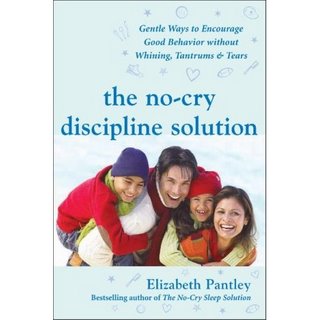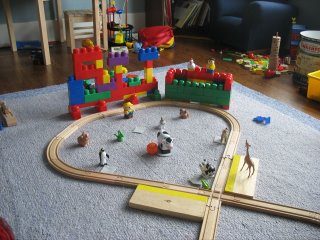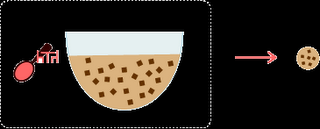MotherTalk Blog Book Tour: The No-Cry Discipline Solution

When Ben was about a year old and Tony and I were beginning to despair of ever getting an uninterrupted night’s sleep again, we attended a baby sleep seminar (we only had one kid, so we had time for things like this). The seminar, led by the same calm and competent woman who’d taught our birth and nursing classes, ran through the basic information about what disrupts a baby’s sleep (teething; stomach upset; brain development; disturbances in the force…) and various approaches to handling them. She covered Ferber, she covered Weisbluth, and then she mentioned a new book, by Elizabeth Pantley: The No-Cry Sleep Solution. I was sold by the title alone, which set her ideas well apart from the other, more well-known sleep docs. I was not about to put Ben in his crib, shut the door, and leave the room. I didn’t believe that would teach him anything that I wanted him to learn.
So I bought Pantley’s book and read it thoroughly. She advises that you start by making charts of your child’s sleeping and waking patterns, and I still have one of these, of a fairly typical night. I wrote:
Last night Ben slept from 7:15-8:15; 9:20-12:30; 1-2:30; 3-4:15; 4:30-6; 6:30-8:15. Oy.
But after a couple weeks of somewhat demoralizing charting, I began to see some patterns, began to be able to pat him down to sleep again without always nursing him, and slowly, gradually, our nights improved. And neither of us cried about it.
Now, perhaps our nights would have improved without my charts, but Pantley’s book, with its tables and graphs, its supportive advice and its frequent quotations from other parents, helped make me feel like I was not alone, like I was taking steps to improve our situation and, most importantly, like it was going to get better. And it did.
So I was already inclined to like The No-Cry Discipline Solution, and when I saw that MotherTalk wanted reviewers, I signed up because while sleep is no longer an issue (some combination of our experience and Eli’s personality means Eli has always slept more easily than his older brother), discipline certainly is. I don’t know what’s to come, but right now, I can’t imagine two more intense subjects for discipline than a 5 year-old and a 2 year-old. We are Discipline Hungry around here, and I ate Pantley’s book right up.
First of all, lest you get the impression from her title that this book will have you tiptoeing around your kids, afraid to discipline them lest they shatter like so many wineglasses, don’t worry. Pantley’s not looking to provoke tears, but she acknowledges—often– that telling your kids no is going to upset them, and that’s ok. As she puts it, “You want your child to be unhappy about his misbehavior and the consequences it brings. This leads to better self-discipline and will help him to make decisions about how to act.” But I do agree with her that once the crying starts (my child’s or mine!) the opportunity for reasoned conversation, thoughtful reflection, or calm acceptance has been lost. And given how rarely those opportunities come at all, I don’t want to deliberately forestall them. So no-cry, here we go.
The opening section clearly and concisely sets out a foundation for discipline. She dispels myths that can get in the way of parenting well (“Good parents don’t lose their patience”) and promotes attitudes that support it (“Parents who do the right thing 70% of the time should feel proud of the job they are doing.”) She connects how you parent a teenager with how that child’s been parented as a kid, and I love the chart which makes it all look so clear: “Typical Older Child Behavior (leaves dirty dishes/clothes around the house); Preferred Behavior (obvious!); “How to Help Your Young Child Develop Preferred Behavior (as a Toddler, Preschooler, or Young Child).” Now, of course I know (and Pantley acknowledges) that it’s not always a direct route from A to B, but still I find such charts comforting; they suggest that there’s a possibility of success.
This section offered a lot of information I already know. I’m fortunate to parent in the context of a co-operative preschool, and we gather frequently for parent education meetings and more informal gatherings that cover a lot of Pantley’s material. Still, it’s useful to have the information gathered in one place, by a writer with a cheerful and encouraging tone. Sometimes it’s just helpful to pick up a book that tells you: “Keep in mind that [your child] isn’t out to get you, he isn’t trying to anger you, and he doesn’t have a master plan to drive you crazy. He’s just going about life in his blissful little world.” I like all the book’s quotations from parents, too, which offer a community like my preschool community; the remarks remind you that you’re not going it alone. The lovely pictures of kids throughout the book remind you why you make the effort (I’m going to keep flipping to the picture of Tristan, on page 137, when I need a laugh).
The second section, building on the first, offers basic parenting skills and tools. She starts with a list of the various problems that can trigger difficult behavior and offers ways to address them. Again, these are set out in a clear and concise way: Problem (Tiredness, for example), Solutions (make sure your kids gets naps; try not to drag them around on a day’s worth of errands; etc.) She offers a long list of strategies to get you through a tricky transition or diffuse a temper tantrum, from playacting to happy face cards to time outs. Some are silly, some are serious, but since one size doesn’t fit all, it’s great to have loads to choose from. Here, as in the rest of the book, Pantley offers charts, quotations from parents, a “reminder page,” for those of us with short attention spans, with a list of strategies; she’s offering a lot of information and makes it both easy to find and easy to use.
The third section, on anger, is the one I really focused on, because lately this is my biggest issue. I can absorb all kinds of good advice about disciplining my kids, but if I can’t speak to them without losing my temper, then they’re not going to hear it. The trick, for me, has always been that the big stuff doesn’t necessarily make me angry, and an easy day after a good night’s sleep doesn’t always guarantee a day without a flare-up. I can sail pretty calmly through playground meltdowns, grocery store whining, or my five year-old’s recent chant “You don’t know anything about me! You don’t know my feelings!” with a quiet, “I’m sorry you’re feeling like that right now,” but then find myself surprisingly worked up by a bit of toothpaste flying off the toothbrush into my hair. I grab the toothbrush from the out-of-control hand while part of me watches me lose my temper and thinks, “Really? This is the battle you’re fighting today?”
But as Pantley reassures us, this is normal. This happens because we’re doing this hard work — guiding willful people through the day, all day long, often without much support, parenting moving targets, kids whose ideas and needs change without warning–and because we are human, our reactions don’t always fit the perceived crime. What hel
ped me even more is her reminder that adults need reminders and test limits, too. We don’t always obey the known rules; we sometimes, willfully and consciously, “disobey.” Think about it. Why else are there speed limit signs posted every five miles on the highway? So Pantley offers a plan to manage anger, and even more helpfully, ideas on how to identify and reduce the situations that cause anger.
It has worked for me. In the past few days, we’ve endured an unusual series of bedtime meltdowns sparked by my refusing Ben’s last-minute requests for more dinner, dessert, more playtime, more books, etc. I’ve been hit, kicked, and called “Stupid butt-head Caroline” by my usually even-tempered and peaceful five year-old. And tempting though it has been to march him into his room, turn out the light, and slam the door, I’ve instead managed to keep some perspective. Two of his good friends are moving away next month. He is graduating from preschool next week. His little brother is suddenly a very active player in our games and our family plans. We haven’t gotten to the part where he doesn’t melt down at all, but we’re working on that, and in the meantime, I haven’t lost my temper with him since reading Pantley’s book. Tony and I have already spent time talking about adopting some of her ideas, and as soon as I finish this review, he’ll start reading the book.
The final section, “Specific Solutions for Everyday Problems,” offers an alphabetical list of the misbehaviors a parent has to deal with, from babytalk to yelling, and capsule strategies to address them. The section and its epigraph give you a great sense of the overall tone of Pantley’s book:
The list of topics in this section sounds like my three-year-old daughter’s daily to-do list!
It’s a serious book, but it knows humor can help. Here, and with its charts, its clear, non-patronizing tone, its careful repetition, the book simply models the approach it suggests we take with our kids.
This is not the first book about discipline that I’ve read, but I think it may be the last. Pantley isn’t afraid of writing out the obvious, and that turns out to be helpful to read, so I’ll leave you with one more quotation:
Children are childish. Children are inexperienced, naïve, and narcissistic. They have limited knowledge about social rules and expected behavior. Furthermore, they are separate people from us and they have free will.
Someone without kids might read this and think, why bother? But I read this and smile. Indeed, they are separate people, they have free will, and doesn’t that just make the days interesting?!











